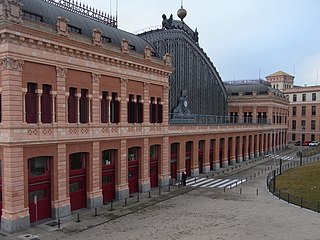
Madrid Atocha is the largest railway station in Madrid. It is the primary station serving commuter trains (Cercanías), intercity and regional trains from the south, and the AVE high speed trains from Barcelona (Catalonia), Zaragoza (Aragon), Sevilla (Andalusia), Málaga (Andalusia), Valencia and Alicante. These train services are run by the Spanish national rail company, Renfe. As of 2018, this station has daily services to Marseille in France.

The Buen Retiro Park, Retiro Park or simply El Retiro is one of the largest parks of the city of Madrid, Spain. The park belonged to the Spanish Monarchy until the late 19th century, when it became a public park.

The Royal Palace of Madrid is the official residence of the Spanish Royal Family at the city of Madrid, although now only used for state ceremonies. The palace has 135,000 square metres (1,450,000 sq ft) of floor space and contains 3,418 rooms. It is the largest functioning Royal Palace and the largest by floor area in Europe.

The Paseo del Prado is one of the main boulevards in Madrid, Spain. The Paseo del Prado is the oldest historical city street in Madrid and was declared Bien de Interés Cultural (BIC). It runs north-south between the Plaza de Cibeles and the Plaza del Emperador Carlos V, with the Plaza de Cánovas del Castillo lying approximately in the middle. The Paseo del Prado forms the southern end of the city's central axis.
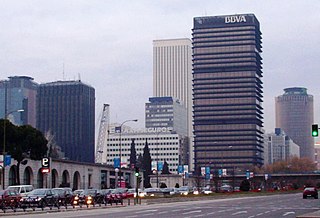
AZCA, an acronym for Asociación Mixta de Compensación de la Manzana A de la Zona Comercial de la Avenida del Generalísimo, is a financial district in downtown Madrid, Spain.
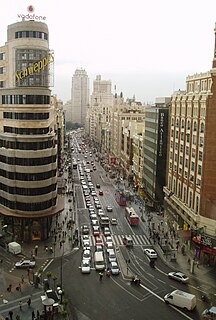
Centro is the central district of the city of Madrid, Spain. It is approximately 5.23 km² in size. It has a population of 149,718 people and a population density of 28,587/km².
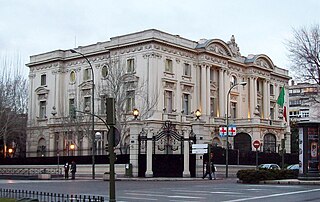
Salamanca is one of the 21 districts that form the city of Madrid, Spain. Salamanca is located to the northeast of the historical center of Madrid. Salamanca lies east of the district of Chamberí, north of Chamartín, and south of Retiro. Salamanca counts approximately 151.000 inhabitants.

Paseo de Recoletos is a wide boulevard in central Madrid leading from Plaza de Cibeles to Plaza de Colón.
Madrid, the capital city of Spain, is divided into 21 districts (distritos), which are further subdivided into 128 administrative wards (barrios). Additional neighborhoods exist outside the boundaries of administrative borders.

The Palace of Villamejor is a palace located in Madrid, Spain. The state purchased it in 1914 to serve as the residence of the Prime Minister, a role that it maintained until 1976, when Adolfo Suárez moved the official residence over to the Palace of Moncloa. The palace now houses the Ministry for Territorial Policy. It was declared a Property of Cultural Interest in 2003.
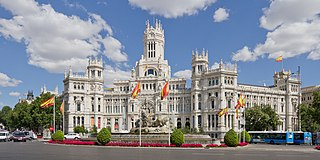
Cybele Palace, formally known as Palacio de Comunicaciones and Palacio de Telecomunicaciones until 2011, is a complex composed of two building with white facades and is located in one of the historical centres of Madrid, Spain.

Madrid is the capital of Spain and the largest municipality in both the Community of Madrid and Spain as a whole. The city has almost 3.3 million inhabitants and a metropolitan area population of approximately 6.5 million. It is the third-largest city in the European Union (EU), smaller than only London and Berlin, and its monocentric metropolitan area is the third-largest in the EU, smaller only than those of London and Paris. The municipality covers 604.3 km2 (233.3 sq mi).

The architecture of Madrid has preserved the look and feel of many of its historic neighbourhoods and streets, even though Madrid possesses a modern infrastructure. Its landmarks include the Royal Palace of Madrid; the Royal Theatre with its restored 1850 Opera House; the Buen Retiro Park, founded in 1631; the 19th-century National Library building containing some of Spain's historical archives; a large number of national museums, and the Golden Triangle of Art, located along the Paseo del Prado and comprising three art museums: Prado Museum, the Reina Sofía Museum, a museum of modern art, and the Thyssen-Bornemisza Museum, which completes the shortcomings of the other two museums. Cibeles Palace and Fountain have become the monument symbol of the city.
The Hipódromo de la Castellana, also known as the Estadio del Hipódromo, was a sports facility dedicated to horse racing located on the Paseo de la Castellana in Madrid, Spain. The racecourse was opened in celebration of the wedding of Alfonso XII and María de las Mercedes de Orleans 31 January 1878.

The Palacio de Xifré is a Madrilenian palace now disappeared that was in the Paseo del Prado, at the corner Calle de Lope de Vega, opposite of the Prado Museum. It was one of the best examples of Neo-Mudéjar architecture in Madrid and one of the palaces that the Spanish financial elite of the second half of the 19th century had built along the paseos del Prado, Recoletos and la Castellana.

The Palacio del Marqués de Portugalete was a grand ornate palace built in the 1860s, located at number 56 of the Calle de Alcalá, on the corner of Calle Alfonso XI, in Madrid. Also known as the Palace of Bailén, it belonged to the family of Castaños. It was built by the architect Adolfo Ombretch, who also built the nearby palace of Linares. For many years it was a venue for the wealthy elite to meet and discuss national politics. It was demolished after the Spanish Civil War, and in 1946, in its place, was constructed the building of the National Institute of Forecast, now occupied by the National Institute of Health.
The Palacio del Duque de Arión now disappeared, was in the number 7 of the Paseo de la Castellana, in Madrid (Spain). Was also known as the Palacio de José Campo and Palace of the Marquises of la Puente and Sotomayor, by Joaquín Fernández de Córdoba, who held both titles, he was also who made the plans. Now in its place is the local building of the Spanish Credit Bank (Banesto).

The Palacio del Marqués de Alcañices, also known as Palacio de Alcañices was a building, now disappeared, which was located in the Calle de Alcalá of Madrid on the land that was other building that occupied Luis Méndez de Haro 6th Marquis del Carpio, a favorite of Philip IV. It belonged to the parish of San Sebastián, and occupied the number 74 of the modern numbering of the street; its other façade bordering the Paseo del Prado. Was named after its owners, the last one José Osorio y Silva, mentor of Alfonso XIII, known as Pepe Osorio and the Grand Duke of Sesto, who also held the title of Marquess of Alcañices, among others.

The Palacio de la Ribera was the summer residence of Philip III in Valladolid. It was built in the 17th century (1602-1605) as part of a process of urban transformation upon the establishment of the Spanish Court in Valladolid between 1601 and 1606. The palace was situated at the Huerta del Rey neighborhood, located across the Parque de las Moreras on the right bank of the Pisuerga river. The palace grounds extended from the Puente Mayor to Ribera de Don Periáñez del Corral and delimited at both sides by the Pisuerga river and the Camino del Monasterio del Prado. The palace was gradually abandoned until it became part of the destroyed cultural heritage of Valladolid in 1761. Some ruins of the building are still preserved.

Nuevos Ministerios is a government complex in central Madrid, Spain. Ministries based in the complex include the Ministry of Development, Ministry of Labour and the Ministry of Environment. It is located in the block delimited by the Paseo de la Castellana, the Raimundo Fernández Villaverde street, Agustín de Betancourt street and the San Juan de la Cruz square.






















